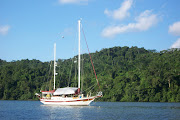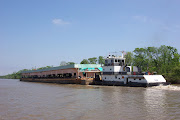 Our Mariner 40 ketch, Sea Trek, had been our home for 17 years until the purchase of our current new to us trawler Beach House. In that time we have lived aboard and cruised her whenever the kitty reached the magic number we had set for our next voyage. Since leaving our previous home base in the
Our Mariner 40 ketch, Sea Trek, had been our home for 17 years until the purchase of our current new to us trawler Beach House. In that time we have lived aboard and cruised her whenever the kitty reached the magic number we had set for our next voyage. Since leaving our previous home base in the
We only spent 127 days at a dock out of 20 months. We anchored behind a reef with nothing but ocean on the other side for thousands of miles. We visited remote Mayan villages and dispensed medicine to a people that once ruled the land in a grand civilization. We visited thousand-year-old ruins of that civilization. It was a grand adventure.
We also spent a few hard-earned dollars. Walk any dock or visit any cruisers’ hang-out or surf the Internet and stop in at any boater’s discussion board and the “How much does it cost?” question always pops up. Our expenditures presented here are for one year only and do not include preparation, gear, provisioning purchased prior to leaving or money needed to get by once you return to reality, but before the paychecks start coming in again. It includes actual money spent from the time we left the dock until the end of the 12th month. Our cruise began April 1, 2005 and the figures are through March 31, 2006 .
We enjoy eating out occasionally, and love to travel and explore the countries we visit. Boat maintenance and repairs are a fact of life and how much you need to budget for repairs is going to be mostly guesswork based on the condition of the boat and the age of your equipment.
Assuming that you have fully outfitted your boat with all the gear — watermaker, life raft, wind generator, solar panels, dinghy and outboard — that you feel you must have to enjoy cruising and to be comfortable and safe, you will then have to provision the boat with foodstuffs and other non-food items. Again, I am not counting this in our expenses, but mention it because there are some items we generally stock up on prior to leaving U.S. waters because they are often difficult or cumbersome to get in remote places. We buy toilet paper and paper towels in large quantities and store them in our largest hanging locker. (The clothes that resided there are packed away for the duration, off the boat and in storage in a friend’s garage.) We also buy as much soda and beer as we can stow on the boat because it is much cheaper in the United States United States Belize
We decided to keep our car instead of selling it this time around so we had the insurance automatically deducted from said account every six months. The car was left with friends, who drove it instead of just letting it sit and rot. Any other bills that may be floating around get sent to us periodically through our mail forwarding service. They are great and will even open the mail and tell us how much the bill is if we can’t access it online, or if we don’t want to pay exorbitant postage to have it sent to us outside of the United States
We also have made the decision not to carry health insurance while cruising outside the United States
Breaking it down
Now, after spending $1,000 or so putting canned foods, paper products, snacks, cookies, juices, shelf milk, rice and so forth into every possible nook and cranny aboard Sea Trek, we are ready to go. The budget consists of about nine months spent in the Western Caribbean and three months in the United States
The amount we spent on dining out was a big shock to us, but we have included all trips to the local ice cream shop and stops for sodas and beer as well as lunches and dinners in restaurants. If it didn’t get consumed on the boat, it was considered dining out. Dockage was a fairly large figure for us, but it seemed we spent more time in marinas for various reasons than we usually do. In some places, anchorages just aren’t available due to shoaling or the anchorages have been replaced by mooring fields. In other areas, like Belize City
So here is how it breaks down for the year:
Auto insurance (recreational use only) – $378.20
Gas for borrowed cars and rentals – $130.21
Bank charges – $270
Boat fuel (diesel and gas) – $1,440.06
Boat insurance (covering Caribbean ) – $2,631.92
Charity – $13
Clothing – $63.02
Dining – $1,792.05
Dockage – $1,833.07
Entertainment – $654.46
Gifts – $229.02
Groceries/provisions – $3,828.54
Housing (boat payments) – $4,479.36
Laundry – $165.10
Maintenance – $888.97
Medical/doctors – $242.50
Medicine – $233.09
Miscellaneous – $730.39
Port fees – $608.83
Postage – $17.28
Subscriptions – $52.86
Taxes and registration – $45.60
Utilities/electric – $161.99
Phone – $304.40
Hotels – $395.07
Travel – $369.66
Our total expenditures for the year were $25,805.10. If your boat is paid off, you’re down to about $21,500 and the amount can be even less if you only anchor out, don’t eat out, etc. Again, we feel this amount is fairly accurate as other friends of ours whose boat is paid off figure they spend about $20,000 for a year off in the wild blue yonder. Surprisingly enough, as I look at our budget for previous years, the costs have not changed dramatically except in the areas of insurance and fuel.Your cruising destination will also determine the final costs. Cruising the eastern Caribbean is much more expensive that our cruise of the western Caribbean.
Behind the numbers
To give you an idea of what boat repairs we encountered, the depth sounder transducer needed to be replaced and it had to be a special length so it cost more than your standard transducer. We hauled the boat and had the bottom painted, which should probably be in the maintenance category, but we had the depth sounder installed at that time so we considered it a repair. We also had our outboard completely rebuilt when it was becoming sluggish. We decided that our anchor rode was a little tired and should be replaced. Also, we had to buy a new microwave oven in Guatemala
Let your needs and considerations be the determining factors to help you compute your costs, but by all means go and have fun.We expect the numbers to change somewhat with the new boat. Fuel costs most certainly will increase and since our cruising grounds will be more towards inland lakes and rivers of the US we must assume other costs will also change. But the numbers still give you a general idea of our costs for long distance cruising. Individual wants and needs and boat size as well as comfort levels will also dictate expenditures.










